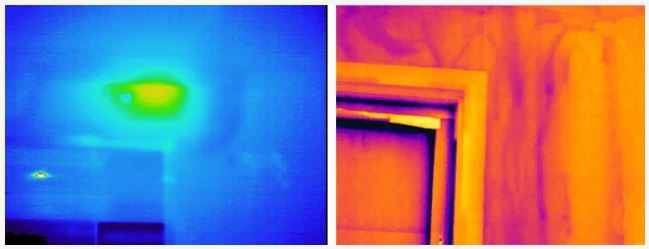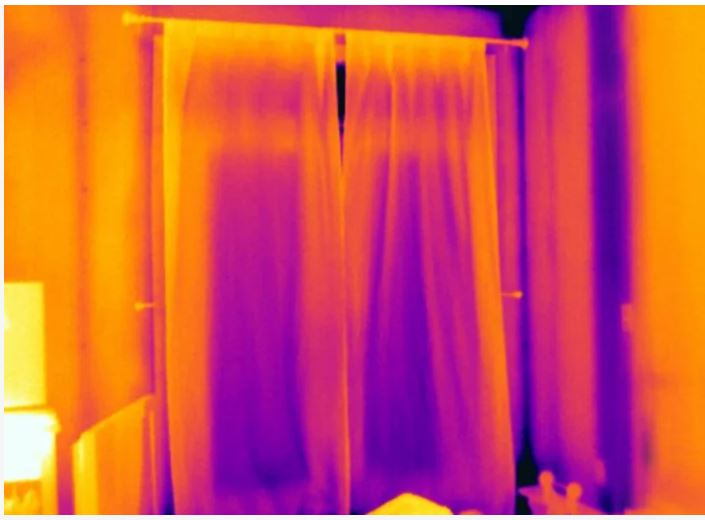Do you have a sixth sense? Maybe you need one!
Do you have a sixth sense? Maybe you need one!
One of the top thermal camera manufacturers, Teledyne FLIR (which stand for “Forward Looking InfraRed”) uses the term “The World’s Sixth Sense” to describe the images they are able to capture with their cameras. For sure, infrared is a totally different way of viewing the world than what we are used to seeing. Infrared does not rely on light to capture images, but rather senses heat and generates an image based on relative differences in heat energy. With an infrared (IR) camera, you could see your cat hiding in the corner of a pitch dark room, which is something “night vision” may or may not pick up, depending on the true ambient light level.
But beyond avoiding cat attacks, is it useful to the average homeowner? Oh, very! There are some gadgets, like a cake pop maker, that have extremely limited use and seem to sit in your junk drawer more than they get used. A thermal imaging camera doesn’t fall into that category. Here are some of the varied uses from different industries that might be applied to your own home:
Electrical Wiring maintenance: why does that breaker keep tripping? Are any wall switches or plugs excessively hot?
These are thermal and visual images of a damaged electrical plug (Fluke.com)
Security: who or what made that noise outside the window?
Animal Health: where is your pet experiencing “hot spots” or possible infection?
Lost pets: A pet hamster or lizard can be found much faster with a thermal camera (if it’s still alive).
Gas Detection: when an infrared camera is pointed at a surface having a gas leak, it shows the temperature difference at the point of a leak caused by the pressure variance. (Top Applications of Thermal Imaging Cameras)
Water Heater or water line maintenance: a temperature difference can show where corrosion may be progressing on an older tank, just as oil industry professionals can use them to “see” corrosion.
Heat loss in common appliances like stoves, refrigerators, dryers and vent lines, etc.
Insulation: check for air sealing problems in your attic, walls, basement and crawlspace (check this video on how to “see” duct leaks)
Roof inspection: see where water may be leaking through your roof
Water leaks: spot the leak inside walls or ceilings without ripping them up.
Pests: Locate mice, bats, squirrels, termites, hornets and all sorts of warm-bodied creatures in and around your home. Snakes, unfortunately, will not show up on an infrared camera because their body temperature is too close to their surroundings. The following images are of a termite’s nest (left) and streaks that indicate termite tunnels (right) (Detecting Pests with Thermal Imaging). The slightly higher moisture content associated with termite tunnels needs a camera with a higher sensitivity.
House hunting: take your thermal camera to reveal hidden insulation and wiring problems.
Car maintenance: see if any components are overheating, and possibly spot leaks, as in brakes, tires, radiators, coolant lines, and exhaust systems.
Gardening: You can possibly spot sprinkler line leaks, and underground gas leaks in your yard.
This video shows a plethora of ways to use a FLIR camera. Although you may not need to locate enemy forces in your backyard, finding a lost pet, hidden water leaks and missing insulation could be well worth its price.
Now that your interest is piqued, it’s best to shop around to find the camera that suits your needs within your budget. Here are some of the main characteristics you’ll want to check out:
Resolution: This is the number of pixels per inch, or PPI. The resolution is usually given in two numbers, which are (Width X Height). Higher resolution numbers give more information in each image, with less grainy edges. Don’t try to compare the resolution of a thermal camera to a regular digital camera, however, because the role of the thermal camera is more of a sensor to detect heat differences. Resolution is not incredibly important if you are mainly using your camera to view large areas like walls and windows, but if you are going to use it to troubleshoot electronic components (much smaller area), you’ll want higher resolution.
Sensitivity: Thermal sensitivity is the ability of a thermal device to distinguish between temperature differences, measured in milliKelvins (mK). (Thermal Sensitivity – Understanding Millikelvins) The lower the number, the higher the sensitivity. For example, 150mK sensitivity means each pixel takes readings to the nearest 0.15˚C.
Sensitivity Range: The range of temperatures the device can sense, for example from -4 deg F to 248 deg F.
Battery Life: Some thermal cameras have an independent, rechargeable battery, while some run off of the battery of the phone they’re attached to. Either way, you’ll need to make sure you have enough battery life to get the job done!
Photo by Teledyne FLIR




